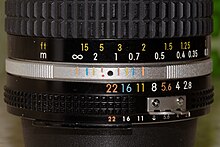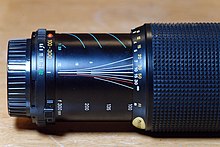


In optics and photography, hyperfocal distance is a distance from a lens beyond which all objects can be brought into an "acceptable" focus. As the hyperfocal distance is the focus distance giving the maximum depth of field, it is the most desirable distance to set the focus of a fixed-focus camera.[1] The hyperfocal distance is entirely dependent upon what level of sharpness is considered to be acceptable.
The hyperfocal distance has a property called "consecutive depths of field", where a lens focused at an object whose distance from the lens is at the hyperfocal distance H will hold a depth of field from H/2 to infinity, if the lens is focused to H/2, the depth of field will be from H/3 to H; if the lens is then focused to H/3, the depth of field will be from H/4 to H/2, etc.
Thomas Sutton and George Dawson first wrote about hyperfocal distance (or "focal range") in 1867.[2] Louis Derr in 1906 may have been the first to derive a formula for hyperfocal distance. Rudolf Kingslake wrote in 1951 about the two methods of measuring hyperfocal distance.
Some cameras have their hyperfocal distance marked on the focus dial. For example, on the Minox LX focusing dial there is a red dot between 2 m and infinity; when the lens is set at the red dot, that is, focused at the hyperfocal distance, the depth of field stretches from 2 m to infinity. Some lenses have markings indicating the hyperfocal range for specific f-stops, also called a depth-of-field scale.[3]
- ^ Kingslake, Rudolf (1951). Lenses in Photography: The Practical Guide to Optics for Photographers. Garden City, NY: Garden City Press.
- ^ Sutton, Thomas; Dawson, George (1867). A Dictionary of Photography. London: Sampson Low, Son & Marston.
- ^ Minolta (1985). Minolta MD Zoom Lenses owner's manual. p. 9.